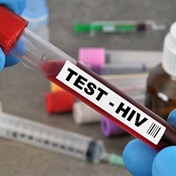A decade ago, there were plenty of doomsday forecasts asserting the Aids pandemic would sharply curtail African economic growth with a particular focus on its impact on food security.
But a series of bumper maize harvests in two of the country’s worst hit by the disease, Zambia and Malawi, suggest the region's economies have not followed this script, thanks in part to treatment programs and farm subsidies.
The predicted scenarios generally went like this: subsistence farming would be devastated because working-age peasants would sicken or die, leaving the back-breaking labour in the fields to the young and the old, with yields suffering.
AIDS was seen as potentially a greater economic shock to Africa than the bubonic plague was to Europe centuries ago as the latter killed far more of the very young and the very old than it did those in the prime of their lives.
Malawi gripped by food shortage
The examples of Malawi and Zambia may force a rethink of how the pandemic is playing out in African economies and suggests the continent is winning key battles against the disease.
A few years ago Malawi was gripped by food shortages and rural residents risked crocodile attack to scour rivers for plants that offered scant nutrition but prevented starvation.
But over the past several years, Malawi and Zambia have been reaping bumper harvests, boosting economic growth in two countries where small-scale farming still accounts for a big chunk of gross domestic product.
Zambia's maize production in the 2010/2011 season was a record of over 3 million tonnes, up from the 2.8 million tonnes produced in the 2009/2010 season. This is over double what it was growing a few years ago, according to government data.
Production to be less this year
Malawi has also had record crops and its maize output has also more than doubled, from 1.7 million tonnes in 2003/04 to 3.8 million last year - an astonishing turn-around.
Both countries are expected to produce less this season than last because of weather-related factors but should still have more than enough to feed themselves.
This state of affairs has been mostly attributed to subsidy programmes in both countries that provide seed and fertilizer to hundreds of thousands of peasant farmers.
Aids deaths on decline
Yet it is perhaps no accident that, according to data compiled by UNAIDS, the Aids death rates for both countries peaked in 2004 and then started dropping off - a trend that generally coincided with increasing maize production.
In Malawi, the annual number of Aids deaths is estimated by UNAIDS to have peaked at around 70,000 in 2004 and fell to 50,000 by 2008. Zambia's situation has been similar.
A dropping death rate suggests fewer workers are being felled in the fields and also means they are not becoming incapacitated by the illness as fast.
This is in large part because of the roll-out of antiretroviral therapy. In Malawi over 250,000 people have received such treatment.
Number of infections doubling
The success of the drugs is underscored by the fact that while death rates are in decline, the sheer number of people in both countries with Aids has still been rising, doubling over the past two decades to around a million in each.
The prevalence rate among 15 to 49 year-olds also appears to have peaked though it remains over 10% in both countries.
According to the prophets of Aids doom, the consequences for African economies would not stop at rural fields. Consumer demand was seen depressed as workers died and families deprived of breadwinners struggled to cope.
An army of feral Aids orphans would fuel already chilling rates of violent crime, deterring badly needed investment, while sectors such as mining would lose vital workers and skills.
Crime rates falling in SA
Things have not unfolded in precisely this manner.
Crime rates in South Africa, while still sky-high, have been falling despite huge numbers of Aids orphans, while the retail sector on the continent has blasted off.
The Economist last year calculated that from 2001-2010, six of the world's 10 fastest growing economies were in Africa - the region which as a whole has the biggest AIDS case load.
A lot of number-crunching and analysis still needs to be done on the role that AIDS is playing in all of this and there are many unknowns at work here.
Aids a human tragedy in Africa
Fast-growing African economies and the harvests in Zambia and Malawi may have been even bigger were it not for burdens related to Aids.
Rural economies may be showing unexpected resilience in the face of the pandemic because of extended family ties. When the household head dies, a sibling or cousin may step in to help.
Aids is clearly an on-going human and social tragedy in Africa. But it does seem that the risks to economic growth and food security have not been as great as many had feared.
(Ed Stoddard, Reuters Health, June 2012)
Read more:




 Publications
Publications
 Partners
Partners














